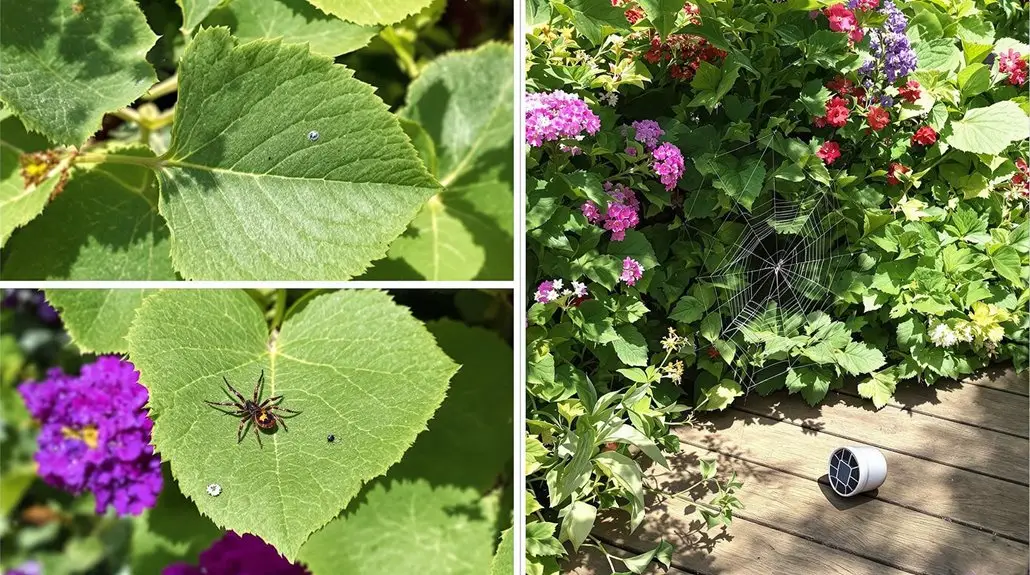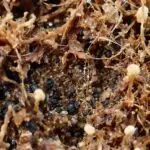To keep pests away from your house, look for signs like droppings, gnaw marks, or discarded wings. Check for entry points, such as cracks in foundations or gaps around windows and doors. Be aware of common pests like cockroaches, ants, and rodents, which might indicate an infestation. You should also maintain cleanliness to reduce attractants and guarantee proper storage of food. Regular inspections are key to catching issues early. By staying informed, you can tackle any pest problems effectively and guarantee a comfortable living space. There’s more essential information that can help you maintain a pest-free home.
Key Insights
- Inspect for cracks and gaps in foundations, walls, and around windows that can serve as entry points for pests.
- Look for visible trails of ants or droppings from rodents and insects, indicating potential infestations.
- Check for signs of termites, such as discarded wings, mud tubes, and hollow-sounding wood in your home.
- Maintain cleanliness by regularly cleaning kitchens and bathrooms to eliminate attractants like food and moisture.
- Ensure proper sealing of food containers and repair leaks to reduce pest access and breeding sites indoors.
Identifying Common Household Pests
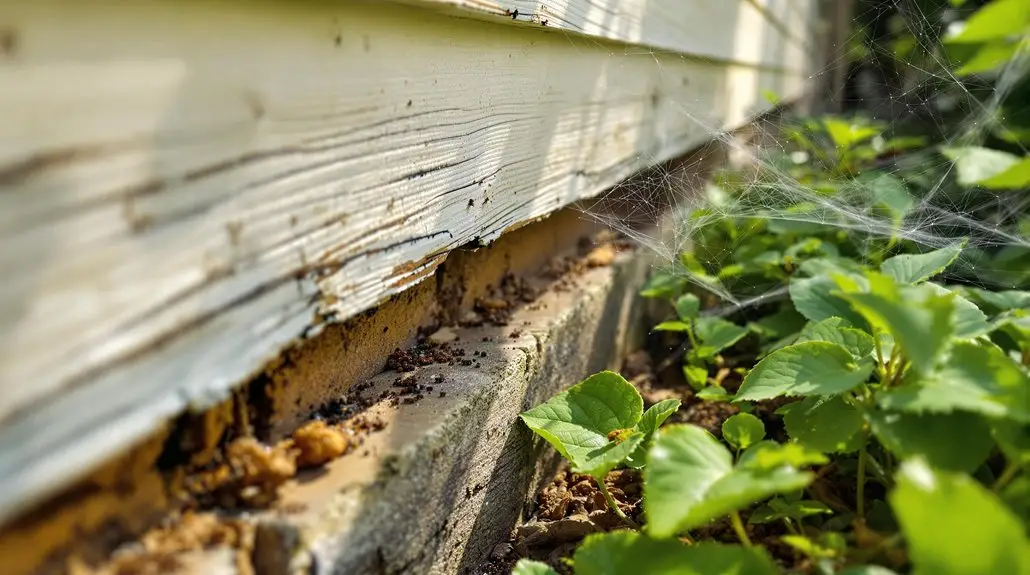
Identifying common household pests is essential for maintaining a healthy living environment. You want your home to be a secure haven, free from unwanted guests.
Start by keeping an eye out for cockroaches. These nocturnal creatures often scatter when you flip on the lights. Look for droppings resembling coffee grounds and a musty odor that hints at their presence. Cockroaches are known for their quick infestations, making early detection crucial. Implementing eco-friendly solutions can help eliminate them effectively.
Ants are another frequent visitor. If you notice visible trails, especially in the kitchen, you likely have a colony searching for food. Check for small piles of dirt or discarded wings near entry points; these can be telltale signs of their activities.
Termites are sneaky, often causing damage before you even realize they’re there. Look for discarded wings, mud tubes on walls, or wood that sounds hollow when tapped.
Rodents leave behind droppings, gnaw marks, and chewed food packaging, so be vigilant in your search.
If you share your home with pets, watch for fleas. Excessive scratching can indicate a flea infestation, and their droppings look like tiny black pepper flecks in bedding or on carpets.
Common areas where these pests like to gather include kitchens, bathrooms, and basements.
Characteristics for Pest Identification
Recognizing the specific characteristics of pests is key to effective pest control. When you spot an unwelcome visitor, start by examining its shape. Is it elongated, flat, or rounded? The overall shape, including the distinct regions of the head, thorax, and abdomen, can provide vital clues.
Next, evaluate the size—measuring or estimating it helps narrow down the species. Don’t forget about color and markings. The hues and patterns on a pest’s body can be telling. Additionally, count the legs; most insects sport three pairs, totaling six. If the pest has wings, note their structure, shape, and color too.
Diagnostic features also play a significant role. Check for antennae—are they long, short, or uniquely shaped? Look at the mouthparts; they can reveal whether the pest bites, sucks, or siphons its food. If you’re dealing with winged pests, observe their wing structure closely. Understanding the presence of common pests in Florida is crucial for proper identification.
It’s essential to reflect on the pest’s life cycle. Are you seeing eggs, larvae, or adults? Identifying the stage can guide your control efforts. Additionally, utilizing licensed pest control professionals can greatly enhance your identification accuracy and provide tailored solutions.
Common Entry Points for Pests
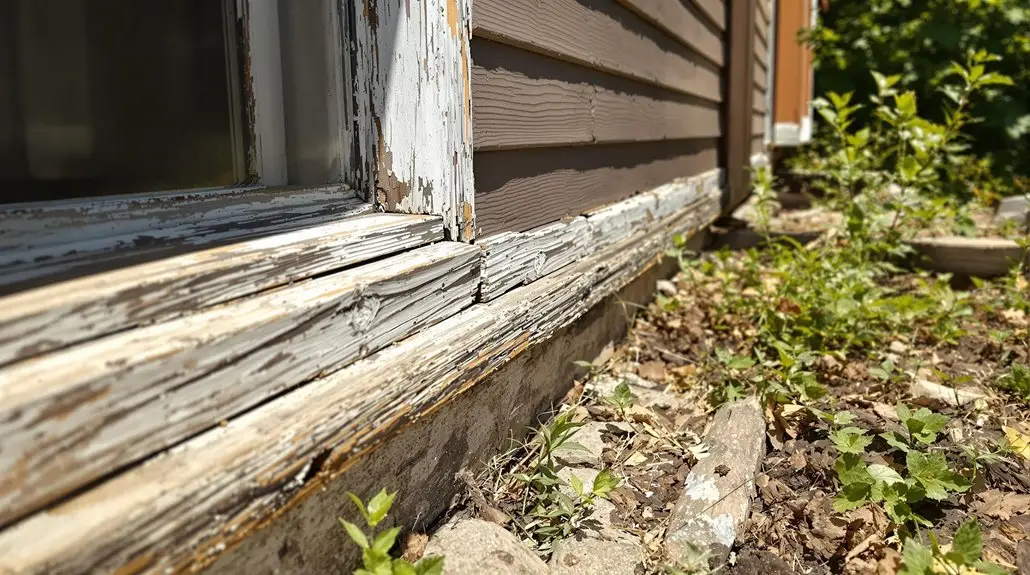
When it comes to pest control, it’s essential to identify common entry points around your home. Cracks and gaps in foundations, vents, and ground-level entryways can all serve as gateways for unwanted visitors. Regular inspections for worn-out weather stripping can help prevent insect access through doors and windows. Additionally, addressing landscape insect pest control can significantly reduce the chances of pests infiltrating your home through outdoor plants.
Cracks and Gaps
Cracks and gaps around your home can be inviting entry points for pests, making it vital to address them promptly. Small foundation cracks might seem harmless, but they can lead to pest infestations if left unchecked. You can easily fill these with silicone-based caulk, while larger gaps may need expandable foam or concrete patch.
Don’t overlook cracks under decks or beneath your house—these spots often attract insects and rodents. Effective pest control is crucial in preventing these infestations from becoming established.
Check your doors and windows, too. Gaps between them and their frames can be sealed with caulk, and replacing worn-out weather stripping is a must. Proper sealing can effectively deter various pests from entering your home.
Verify your screens are tear-free and that door sweeps fit snugly against the threshold.
Your siding and exterior walls deserve attention as well. Repair or replace any gaps, cracks, or signs of rot. Small holes can be filled with wood filler, while larger ones may need foam.
Lastly, inspect utility lines and pipes. Seal any openings with caulk or foam sealant, and consider using steel wool for larger holes before applying a sealant.
Regular inspections will help you stay ahead of potential pest problems and keep your home protected and inviting.
Vents and Ducts
Exposed vents and ducts can serve as easy entry points for pests, making it necessary to address any vulnerabilities promptly. Uncovered or damaged vents invite unwanted visitors like bugs and rodents into your home. Regular inspection of vent openings is crucial for pest prevention. Additionally, utilizing organic pest control methods can further enhance your home’s defenses against infestations.
Installing screens or mesh can be an effective barrier, but remember to regularly check for wear and tear—chewed screens need replacing to maintain that protection.
Keep an eye out for signs of infestation. Odd smells and scurrying noises coming from the ductwork can indicate a problem. Look for nest material, droppings, or scratch marks near vent openings, and don’t ignore the presence of blowflies or other insects.
To prevent pests, seal any holes or cracks in the ductwork and install vent screens. Fixing leaks around your air conditioning unit is essential as moisture can attract pests.
Maintaining a clean area around vents and eliminating food sources will also help in keeping your home pest-free.
If you spot a pest issue, turn off the HVAC system and consider using traps near vent openings. After removal, professional duct cleaning and repairs are important to guarantee your home stays welcoming and comfortable.
Ground-Level Entryways
Securing ground-level entryways is vital for keeping pests at bay. You mightn’t realize it, but small cracks in your foundation can be a welcome mat for unwanted guests like mice and ants. Temperature changes can cause these cracks, so it’s important to inspect your home regularly. If you find minor gaps, simply use caulk or expanding foam to seal them up.
Don’t forget about your garage and basement. These areas can provide easy access for rodents if you overlook openings around garage doors or basement windows. Installing weatherstripping or screens can make a big difference. Cracks in foundation can exacerbate the risk of mice entering your home.
Also, pay attention to utility lines. Gaps where pipes and cables enter your home can be direct highways for pests. Make sure these areas are sealed properly to maintain your pest-free sanctuary.
Lastly, keep your exterior tidy. Clutter like woodpiles and poorly sealed corners can attract rodents. By surveying your home’s perimeter and addressing these potential entry points, you’ll create a welcoming space for your family, not pests.
Taking these steps shows you care about your home and those who belong in it.
Signs of Infestation
When you notice visible signs of pests in your home, it’s vital to act quickly. Look for droppings, which can vary from small pellets to tiny peppery grains, as well as dead insects around windows and doors. These indicators not only signal an infestation but also highlight the need for immediate pest control measures. Additionally, regular inspections can help identify potential issues before they escalate into larger infestations.
Visible Pest Sightings
Noticing visible pest sightings around your home can be a clear indicator of an infestation. If you spot live insects like cockroaches scuttling across your kitchen or bathroom—especially at night—it’s time to take action.
Rodents, such as rats and mice, also tend to show up after dark, so keep an eye out for them as they scurry about. Ants trailing along walls, floors, or countertops can signal a larger problem, too.
You might also encounter termites, particularly swarmers, which leave discarded wings near windowsills or doors. Flies buzzing around food or trash are another sign that pests are taking over. Pests like cockroaches and rodents carry diseases that can contaminate surfaces and food, leading to health issues for inhabitants.
It’s not just about being grossed out; these sightings can disrupt your sense of belonging in your home. If you’re seeing these pests, don’t ignore it.
Addressing the issue early on helps maintain a secure and comfortable environment for you and your loved ones. Remember, you deserve a home that feels inviting and pest-free, so stay vigilant and act quickly when you spot any signs of trouble.
Droppings and Waste
Visible pest sightings are often just the tip of the iceberg when it comes to identifying an infestation. One of the most telling signs you should look for is droppings.
If you find small, pellet-like droppings the size of a grain of rice, you might be dealing with mice. Larger droppings, dark brown and smooth on one side, typically indicate a rat problem. You’ll often spot these droppings in cabinets, kitchens, or attics, close to food sources.
Cockroach droppings are another red flag. These small, dark pellets can sometimes shine due to an oily coating. If you see them near food areas, it’s time to act.
Termite droppings, known as frass, resemble sawdust and signal a serious issue that could compromise your home’s structure.
Pest Control Methods

Effective pest control methods are essential for maintaining a protected and comfortable home. You want to create a space that feels secure and welcoming, free from unwanted guests. Start by identifying any pests you encounter. Take note of their characteristics—shape, size, color, and whether they’ve wings or antennae. Classifying them into categories like insects or rodents can help you understand the best control strategies. Compare your findings with images in guides and read about their habits and signs of infestation.
Prevention is your first line of defense. Keep your home tidy to reduce attractants. Seal entry points by caulking cracks around doors and windows, and consider adding weather stripping. Don’t forget to reduce moisture in areas like basements and bathrooms, which often draw pests in. Store firewood outside to keep your living space pest-free. Regular inspections can help you identify signs of infestations before they become a larger problem.
When it comes to control methods, think non-chemical first. Use bait stations for ants and cockroaches, and vacuum any nests you find.
If you do need to use chemicals, choose EPA-regulated pesticides at low concentrations, applying them in areas out of reach of children. For severe infestations, don’t hesitate to contact a pest control service. They can provide tailored solutions to fit your needs.
Importance of Regular Inspections
Regular inspections play an essential role in maintaining a pest-free home. By catching infestations early, you can prevent them from escalating into costly problems. Trained professionals know how to spot the subtle signs of pests, like droppings or structural damage, before they become a major headache.
The Environmental Protection Agency emphasizes that early intervention is key to keeping your living environment healthy.
Your home’s structural integrity is another important reason to conduct regular inspections. Pests like termites and rodents can wreak havoc, leading to extensive damage that could cost you thousands. Did you know termite damage alone amounts to over $5 billion annually in the U.S.?
Regular inspections help you catch these destructive pests early and assess any existing damage, allowing you to make necessary repairs before it’s too late.
Moreover, regular inspections contribute to your family’s health and well-being. Many pests, such as rodents and cockroaches, can carry diseases that pose real risks to your loved ones.
Seasonal Pest Considerations
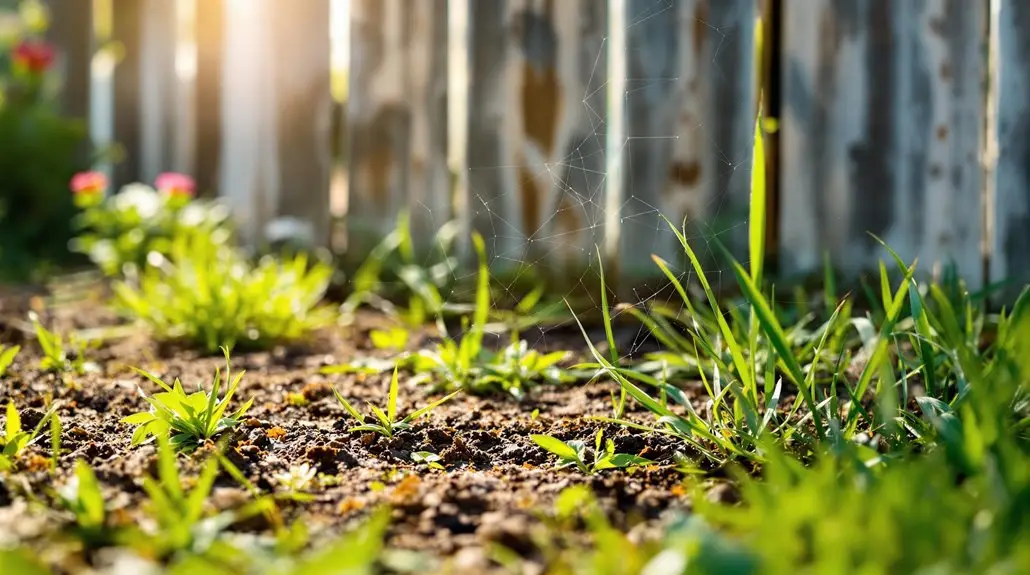
As the seasons change, so do the pests that invade your home, making it essential to adjust your pest control strategies accordingly. Each season brings its own set of challenges, and being proactive can help you maintain a comfortable living space.
Spring: You’ll see ants and termites emerging. To keep them out, seal cracks and inspect for nesting sites. Moisture attracts pests, so address any water issues around your home.
Summer: Expect ants seeking indoor water and mosquitoes thriving in stagnant water. Keep your yard tidy, empty birdbaths weekly, and use repellents.
Remember to maintain a clean kitchen to deter flies and gnats.
Fall: Rodents look for shelter as temperatures drop. Seal up any gaps and clear debris from around your home.
It’s also wise to keep food stored in airtight containers to avoid inviting unwanted guests.
To keep pests at bay, consider these strategies:
- Regularly inspect for potential entry points.
- Store food properly and maintain a clean kitchen.
- Trim back overhanging branches to limit access.
- Use fly screens on windows and doors.
Impact of Weather on Pests
Weather plays an essential role in pest behavior and population dynamics. You might notice that as temperatures rise, insects become more active. Warmer weather boosts the reproduction rates of pests like mosquitoes, flies, and ants, turning your backyard into a breeding ground.
On the flip side, when temperatures drop, cold-blooded pests, such as rodents and cockroaches, often seek warmth indoors, making your home an attractive refuge.
Heavy rainfall can also bring its share of pests. Rodents, which dislike damp conditions, may invade your space in search of shelter and food. Excessive moisture creates ideal breeding spots for mosquitoes, leading to spikes in their populations. If you spot an increase in these pests, check for leaks and standing water around your home.
Humidity has its own impact on pest behavior. High humidity creates a paradise for moisture-loving pests like cockroaches and termites, while low humidity levels can push them inside, resulting in more frequent encounters with you and your family.
Keeping indoor humidity in check with dehumidifiers can help make your home less appealing to these unwanted guests.
Extreme weather events, such as hurricanes and floods, can lead to sudden surges in pest populations. When their natural habitats are destroyed, pests often invade homes, seeking food and refuge.
Safe Pest Control Products
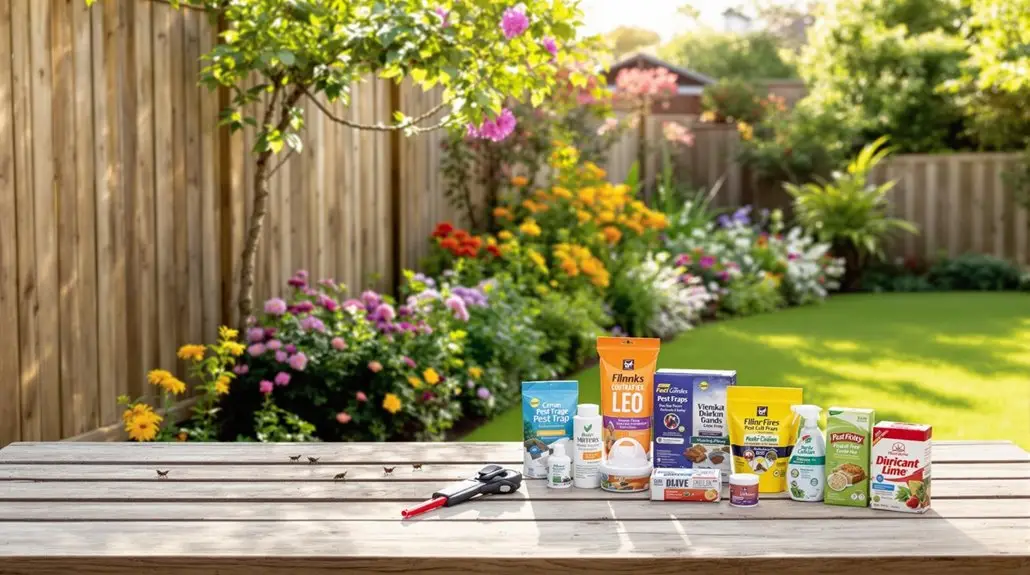
When it comes to pest control, you have options that prioritize security and effectiveness.
Natural pest control products, eco-friendly alternatives, and even some chemical solutions can keep your home pest-free without harming your family or pets.
Let’s explore these choices to find the best fit for your needs.
Natural Pest Control Options
Natural pest control options offer effective and reliable alternatives to chemical pesticides, allowing you to protect your home without harmful side effects. By choosing natural methods, you can foster a healthier environment for both your family and pets.
Here are some great options to contemplate:
- Citronella Oil: Repels mosquitoes; use in candles or sprays.
- Garlic: Mix with water for a spray that deters ants and other pests.
- Cinnamon: Sprinkle around entry points to keep ants and mice at bay.
- Diatomaceous Earth: Sprinkle this natural powder around your home to kill insects by desiccation.
Additionally, think about planting pest-repelling herbs like basil and marigolds or using traps made from everyday items.
These methods not only protect your space but also create a welcoming atmosphere. Remember, natural pest control isn’t just about eliminating pests; it’s about creating a secure haven for you and your loved ones.
Embracing these options can help you feel more connected to your home and community, knowing you’re making choices that benefit everyone.
Chemical Pest Control Products
Chemical pest control products can offer a reliable solution for managing infestations effectively. These products come from both synthetic and natural origins, utilizing active ingredients like neem oil and pyrethrin for a broader pest control effect. Some options even feature essential oils such as geranium and citrus, which can be both effective and pleasant.
When considering chemical pest control, always pay attention to security. Pesticide labels display toxicity signal words like “caution” or “danger,” helping you assess the level of risk. It’s vital to keep vulnerable groups—like children and pregnant women—away from treated areas.
Proper usage is key; always follow label directions to minimize exposure risks and environmental impact. Make certain to choose registered products with a Pest Control Products (PCP) number to guarantee compliance with regulatory standards. After application, keep treated areas off-limits for the specified time to maintain security.
Ultimately, understanding the chemical components and adhering to safety guidelines will help you effectively manage pests while keeping your home and loved ones protected. When done right, chemical pest control can be a valuable part of your pest management toolkit.
Eco-Friendly Alternatives Available
Are you looking for effective yet eco-friendly pest control solutions? You’re not alone! Many folks are turning to natural products that are both secure and sustainable.
Here are some top options you might consider:
- Diatomaceous Earth: This fine powder dehydrates pests by piercing their exoskeletons, making it a powerful yet secure choice.
- Neem Oil: Extracted from the Neem tree, it disrupts insect growth and acts as a natural repellent.
- Pyrethrin: Found in the Pyrethrum daisy, this broad-spectrum insecticide is less toxic to pets and humans compared to synthetic options.
- Essential Oils: Oils like peppermint and tea tree can be mixed with water to repel unwanted visitors.
When using these products, remember to apply them selectively and monitor your space regularly to catch any infestations early.
You can create a pest-friendly environment by planting pest-repelling flowers and keeping your home tidy.
By choosing eco-friendly alternatives, you’re not just protecting your home but also contributing to a healthier planet.
Join the movement toward sustainable pest management today!
Preventive Measures for Homeowners
Regularly implementing preventive measures can greatly reduce the chances of pests invading your home. Start by sealing entry points. Caulk and seal cracks around doors and windows, and don’t forget to weather-strip doors and install new thresholds. This simple step can block pests like pillbugs and sowbugs from getting in.
Repair any holes or gaps in your foundation or walls, and consider installing door sweeps or weatherstripping on garage doors to keep unwanted guests out.
Keeping your home clean is another essential step. Regularly clean your kitchen and bathrooms to eliminate attractants for pests such as cockroaches and ants. Store food in sealed containers and promptly clean up any crumbs or spills.
Dispose of garbage regularly, making sure trash cans are clean and covered to avoid enticing pests.
Managing moisture is key as well. Fix any leaks to reduce damp areas that attract pests like silverfish. Using a dehumidifier in basements and bathrooms can help, too. Guarantee proper ventilation in crawl spaces and attics to keep moisture levels low.
Lastly, store items properly. Use sealed containers for books, papers, and clothing to prevent infestations. Keep firewood outside and organized to limit hiding spots for pests.
Professional Pest Control Services
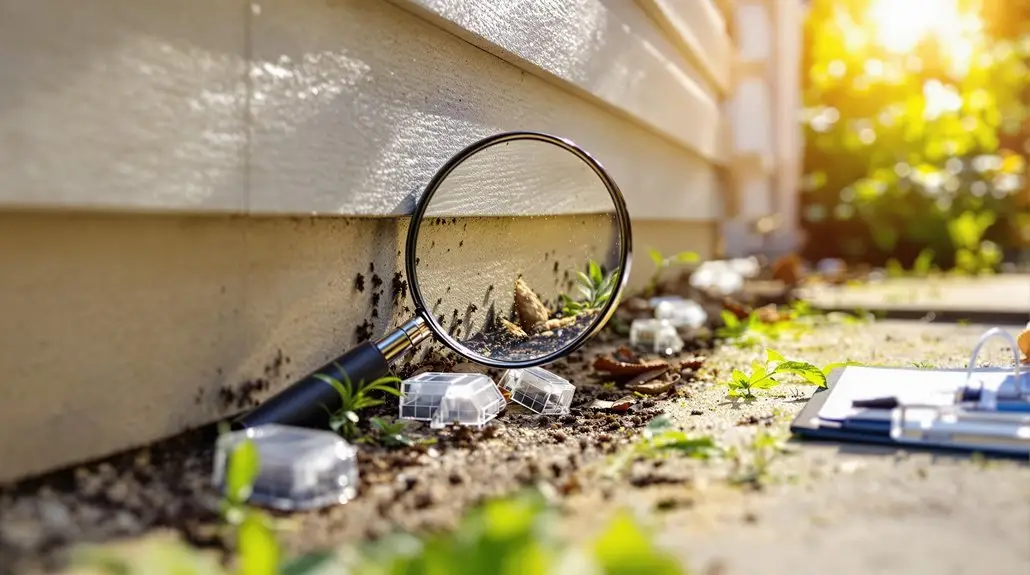
When it comes to pest control, relying on professional services can make all the difference.
These experts bring extensive training and tailored treatment plans that address your specific pest issues effectively.
Importance of Expertise
Steering through the complexities of pest control requires expertise that most homeowners simply don’t have.
When pests invade your space, you need more than just a quick fix.
Professional pest control services bring a wealth of knowledge and skill that guarantees effective and secure treatment.
Here’s why expertise matters:
- Accurate Pest Identification: Professionals can pinpoint the specific pests invading your home, allowing for targeted treatments.
- Safety First: They follow updated safety guidelines, using environmentally friendly products that protect your family and pets.
- Health Protection: Experts eliminate pests that carry diseases, guaranteeing a secure living environment for you and your loved ones.
- Cost and Time Efficiency: Professionals address pest issues quickly, preventing costly damage and saving you valuable time.
Customized Treatment Plans
Professional pest control services don’t just rely on their expertise to tackle infestations; they also create customized treatment plans tailored to your specific needs. These plans begin with thorough inspections of your property, identifying pest hiding spots and potential entry points like cracks and crevices.
By evaluating your home’s structure and environment, professionals can devise a strategy that works best for you. Targeted treatment approaches use advanced technology and industry knowledge to effectively eliminate pests while minimizing exposure to pesticides.
They often employ Integrated Pest Management (IPM), guaranteeing a holistic solution that not only addresses current infestations but also provides advice on preventing future invasions.
With seasonal and year-round protection, you’ll benefit from treatments designed to combat pests specific to each season. Regular inspections and follow-ups confirm your home remains pest-free, and should any issues persist, re-treatment services are often available at no extra cost.
Ultimately, these customized plans foster a sense of security, allowing you to enjoy your home without the worry of unwanted guests. You deserve a living space that feels protected and welcoming, and professional pest control can help achieve that.
Health Risks From Pests
Pests lurking in your home can pose significant health risks that go beyond mere annoyance. From triggering allergies to spreading diseases, these unwelcome guests can seriously impact your well-being and comfort. Here’s what you should be aware of:
- Allergic Reactions: Cockroaches, rodents, and dust mites can trigger asthma attacks and other allergic responses. The droppings and dander left behind can linger long after the pests are gone.
- Disease Transmission: Rodents carry dangerous diseases like hantavirus and salmonellosis, which can spread through direct contact with their waste or indirectly via ticks and fleas. Cockroaches can contaminate surfaces with harmful bacteria.
- Venomous Bites: Stings from wasps or bees can lead to severe allergic reactions, while bites from certain spiders may require medical attention.
- Psychological Effects: The presence of pests like bed bugs can disrupt your peace of mind, leading to anxiety and sleep disturbances.
You deserve a home that feels protected and comfortable. Ignoring these risks can lead to more significant health issues down the line.
Taking steps to address pest problems not only safeguards your physical health but also supports your mental well-being. By understanding these health risks, you’re better equipped to create a space that feels like your sanctuary.
Environmental Impact of Pests
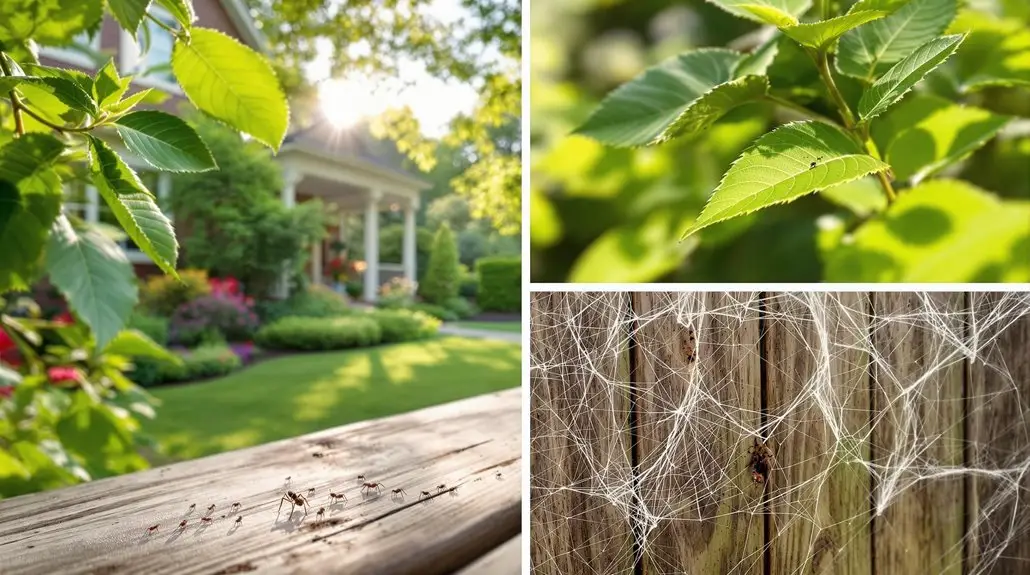
Your home’s ecosystem can be considerably affected by the presence of pests, which often disrupt the delicate balance of nature. When pests invade, they can lead to significant environmental issues that impact not just your garden, but the broader ecosystem as well.
For instance, invasive pests can outcompete native species and introduce harmful diseases, risking the survival of local flora and fauna. This loss of biodiversity can diminish the beauty and health of your surroundings, making it less enjoyable for you and your family.
Chemical pesticides, while effective in controlling pests, can further complicate matters. These chemicals often contaminate soil and water, harming non-target organisms and potentially entering the food chain.
Pesticide runoff can pollute nearby water bodies, affecting aquatic life and even your drinking water. Plus, soil contamination from these chemicals can linger, degrading soil health and the ecosystem over time.
As climate change influences pest distribution, you’ll notice that pests thrive in warmer, humid environments, which may extend their reach into your garden. This can lead to increased crop damage, soil erosion, and nutrient depletion, compromising your ability to enjoy a thriving garden.
Understanding the environmental impact of pests is essential for creating a healthy home environment. By being mindful of these issues, you not only protect your home but also contribute to the well-being of your community and the planet.
Embracing sustainable pest control methods can foster a healthier ecosystem for everyone.
Long-term Pest Management Strategies
Effective long-term pest management strategies rely on a holistic approach that integrates various techniques to maintain a balanced ecosystem.
By focusing on Integrated Pest Management (IPM), you can reduce reliance on chemical pesticides and emphasize prevention over reaction.
Here are some key components you should consider:
- Monitoring and Identification: Regularly scout for pests and accurately identify them. This helps you determine when intervention is necessary and guarantees you’re using the right control methods.
- Preventive and Cultural Methods: Use resistant plant varieties and modify growing conditions. Techniques like tillage, mulching, and proper irrigation can make a significant difference in pest susceptibility.
- Control Methods: Employ a mix of physical, biological, and, when needed, chemical control methods. Using natural predators can be effective, while traps and barriers serve as excellent mechanical solutions.
- Community Engagement: Involve your neighbors in pest management efforts. Educating your community about IPM practices fosters a collaborative environment, leading to long-term success.
Frequently Asked Questions
How Can I Identify the Specific Type of Pest in My Home?
To identify the specific type of pest in your home, start by observing their appearance and behavior.
Look for characteristics like size, color, and body shape. Pay attention to their habits; for example, cockroaches are nocturnal and scatter when you turn on the lights.
Check for droppings, trails, or webs. By noting these signs and details, you’ll better understand what kind of pest you’re dealing with and how to address it.
What Are the Best Natural Remedies for Common Household Pests?
Isn’t it amusing how the tiniest pests can crash your home party?
To keep them at bay, you can try natural remedies like peppermint oil for ants or coffee grounds to repel bugs.
Lemon juice works wonders against spiders, while cucumber peels deter silverfish.
If you’re feeling adventurous, sprinkle some cinnamon around!
With these simple solutions, you’ll feel like a pest control pro, keeping your space welcoming for friends rather than uninvited guests.
Are There Any Pets Safe Around Pest Control Products?
When considering pest control products, it’s essential to think about your pets’ protection.
Always keep them away from treated areas until everything’s dry and follow label instructions carefully.
Opt for pet-friendly or low-toxicity products when possible, and use non-toxic methods like sealing cracks or using physical barriers.
If you’re unsure, consult with pest control professionals about your pets, ensuring their protection while effectively managing pests in your home.
How Often Should I Inspect My Home for Pests?
You should inspect your home for pests at least once a month.
Regular checks help you catch any signs of infestation early, like droppings or trails.
During spring and summer, increase your vigilance, as pests are more active.
After heavy rain or flooding, inspect for moisture, which attracts critters.
When moving in or out, do a thorough check to verify your space is pest-free and ready for a fresh start.
What Should I Do if I Find a Dead Pest in My Home?
When you stumble upon a lifeless pest, it’s like finding a forgotten piece of a puzzle in your home.
First, take note of its features and snap a picture.
Check the surroundings for signs of more critters lurking, as they can easily turn your cozy space into a bustling habitat.
Clean the area, seal any entry points, and don’t hesitate to call a pest control expert if you’re unsure.
You deserve a pest-free haven!
Conclusion
In summary, keeping your home pest-free requires vigilance and knowledge. By recognizing the signs of infestation and understanding common entry points, you can take proactive measures. While DIY methods can be effective, don’t underestimate the benefits of professional services. At NaturePest Holistic Pest Control, we believe in sustainable solutions that not only eliminate pests but also protect your home and the environment. Notably, some studies suggest that certain pests, like spiders, can actually help control other pest populations. So, while it’s essential to manage pest issues, consider the ecological balance. Take action today and contact NaturePest for a consultation to explore long-term solutions that work for you!

